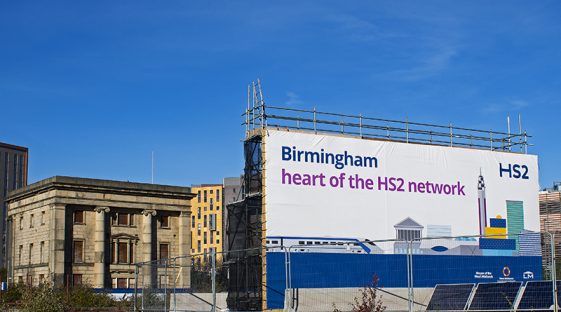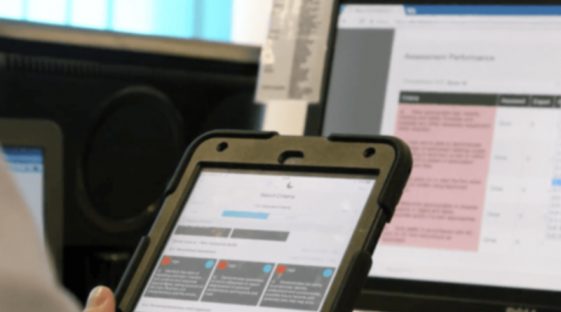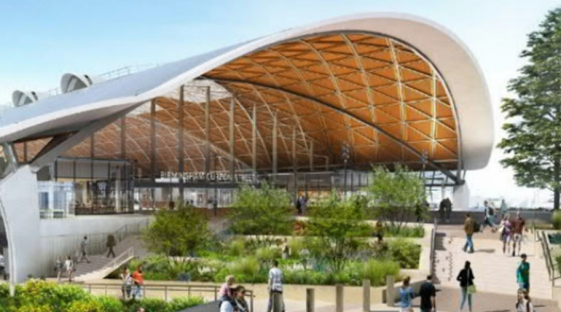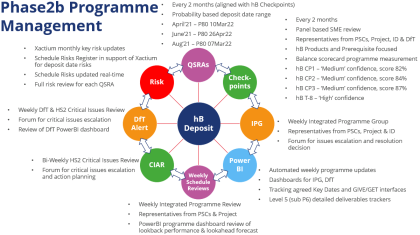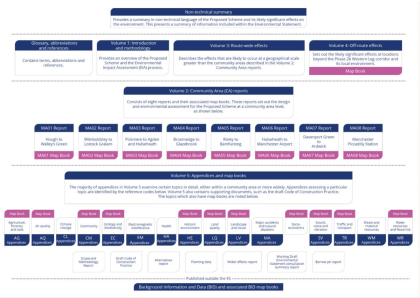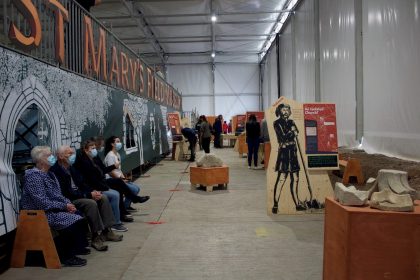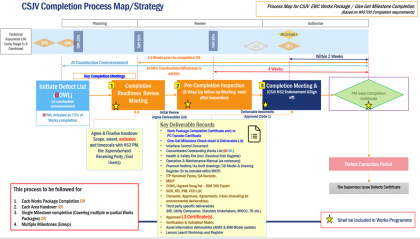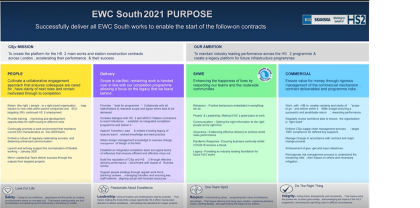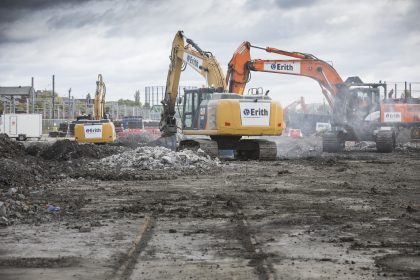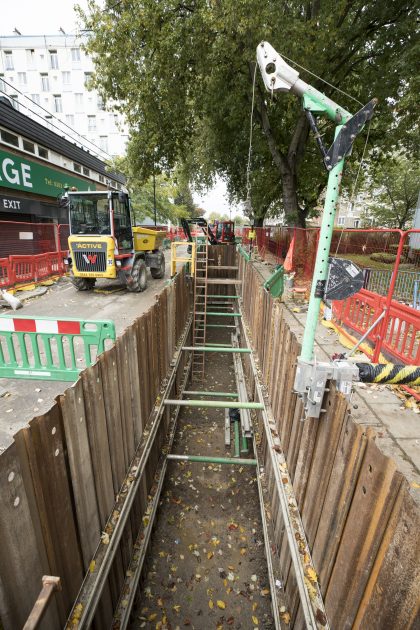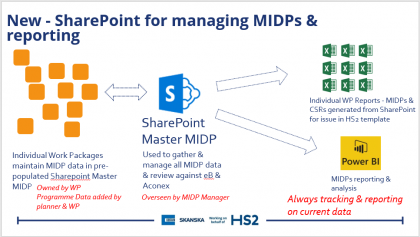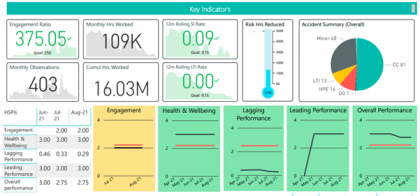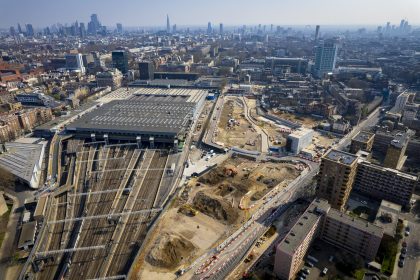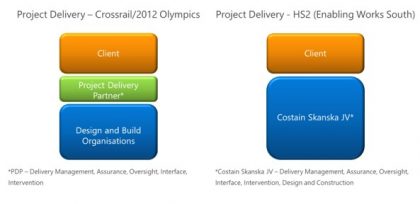Project and Programme Management
The governance framework for major projects including the management, leadership, control and risk management of project initiation, delivery, commissioning and handover.
Topic areas
Project and Programme Management Resources
Resources include papers, videos, research summaries and good practice documents produced by authors from across the HS2 Family to capture learning, good practice and innovation from the HS2 programme
-
Published on
Artificial badger sett design
To mitigate for the loss of badger setts, closed due to construction of the scheme, over 30 artificial badger setts have been constructed across Phase One under a licence from Natural England. HS2 now have at least two years of monitoring for artificial setts and have reviewed data from both the design stage and post-works…
-
Published on
Programme management techniques and tools for complex hybrid Bill submission
The production of the hybrid Bill for the High Speed Rail (Crewe – Manchester) was a complex, multi-stakeholder and multi-disciplined co-ordination under a challenging programme with risks of a minor delay to deposit that could result in a major delay to Royal Assent and following delivery programme. The deposit of the Bill by the Department…
-
Published on
Creating the HS2 Learning Legacy
Learning Legacy has been used on major projects for more than 10 years to capture and share learning from major projects. It was first developed to share the learning from the London 2012 construction programme. Building on the success of the London 2012 Learning Legacy, Crossrail set up its Learning Legacy programme, followed by Thameslink…
-
Published on
HS2 Phase 2b Environmental Statement Management through progressive assurance
The Phase 2b Environmental Statement (ES) was one of the largest produced in the UK in recent years. The ES required inputs from a diverse range of organisations across the supply chain and within HS2 Ltd. In order to facilitate the production of a robust, consistent and proportionate ES compliant with Parliamentary Standing orders, a…
-
Published on
Control of hand and arm vibrations on HS2 and beyond
Hand Arm Vibration Syndrome (HAVS) is a health condition caused by the vibration from any hand-held, fed or guided power tools and machinery on site, e.g. drills, torque wrenches, plate compactors etc. HAVS causes damage to muscles, nerves, joints and blood vessels, leading to permanent long-term health. Over two million people in the utility and…
-
Published on
St Mary’s Church: demonstrating the limitless possibilities and value of on-site archaeological public engagement in construction projects
The St Mary’s Field Museum programme of events demonstrated that it is not only safe and secure to invite members of the public on to a construction site, but that doing so adds great public value and creates a lasting, treasured legacy as a result. Such events provide the opportunity for the public to be…
-
Published on
Designing with landscape maintenance in mind
The HS2 project is delivering built infrastructure and natural environments on an unparalleled scale. The project affords a once in a generation opportunity to deliver nationally significant infrastructure that will respond to local landscape character and demonstrate an innovative and environmentally-sensitive design approach. The project has been developed to minimise it’s impacts on the surrounding…
-
Published on
Management of completion and handover
This paper describes the process of planning and managing completion and handover, in particular the importance of starting at the early stage of a contract, defining processes, requirements and deliverables at each life cycle stage, and providing briefings and specific templates for a standardised approach across a complex and diverse programme of works. The increased…
-
Published on
Collaboration approach between CSjv and HS2 on EWC South
We have worked extremely hard to create a collaborative relationship with HS2, ensuring continued focus on the needs of both delivery partner and HS2, and creating a common approach and consistent output. Through relationships fostered across organisations and aligned through disciplines, we have identified the best person for the job in terms of resolving challenges,…
-
Published on
Monitoring completion health to drive performance and provide scheduling certainty
The EWC south programme of works was in a position where the majority of physical works were finished, but only a handful of projects were formally completed. In order to give certainty of compliant and timely completion for the remaining projects on the programme, a completion health tracker and monthly review panel was established. The…
-
Published on
Planning and managing utilities on HS2 (High Speed 2)
The HS2 Phase 1 utilities portfolio consists of circa 5000 assets impacted by the line and route, defined as diversions, connections, protections, assurance, and removals. As an essential enabling activity for the project, HS2 required a working partnership with the Utility Asset Owner (UAO) to plan, design, deliver the works on the utility assets. There…
-
Published on
Managing leavers to mitigate the impact to project delivery
After the peak of works, many Costain Skanska joint venture (CSJV) team members were offered roles with follow-on High Speed 2 (HS2) contracts which delivered on career progression and job security. The knowledge and experience gained on the Enabling Works Contract (EWC) made these individuals highly sought after. The impact on CSJV resulted in prematurely…
-
Published on
Planning for a smooth and finite transition
The Transition stage of the project lifecycle is the change of state from delivery to operation, which in context for the Enabling Works Contract (EWC) South, relates to successfully enabling the High Speed Two Limited (HS2) scheme’s follow-on contractors. This paper describes the EWC South Transition plan and the three phases of its structured transition…
-
Published on
Super MIDP (Master Information Delivery Plan)
Early identification, adoption and system development for the workflow management of deliverables is critical to overall success of a project. Looking forward, the Super Master Information Delivery Plan (MIDP) should be one of the key data sets sitting under the remit of the Project Information Manager (PIM) who will be able to combine the insight…
-
Published on
BREEAM Infrastructure
This paper details the approach taken by the Enabling Works Contractor of the southern section of High Speed Two (HS2) Phase One to achieve an 'Excellent' score for the BREAAM Infrastructure Interim Assessment. It provides recommendations for how this learning can be applied to other similar contracts on HS2 and wider industry.
-
Published on
PowerBI and its use in performance management reporting
Monthly reporting utilising Excel dashboards proved to be time consuming, require numerous efforts to provide consistent presentation and was not readily providing the detailed information required to enable prompt effective decisions to be taken by the relevant management teams. With the switch to PowerBI, significant benefits were achieved in terms of time savings, consistent presentation,…
-
Published on
12-week look ahead schedule during construction
As part of the Enabling Works Contract for High Speed Two (HS2) Phase One, significant works were required in the congested area around Euston, with many different stakeholders involved. All parties required information about where works were taking place, the nature of these works and the impacts on traffic management in the area. Traffic management…
-
Published on
360-degree trial pit photography
Trial pit photographs captured using conventional digital cameras during ground investigation works are typically of poor quality because of lighting conditions and viewpoint, missing out on key opportunity to capture a photographic record of the in-situ ground conditions. The paper documents the findings of a 360-degree camera photography trial on the Phase 2A ground investigation…
-
Published on
Capturing operational lessons learnt through focused workshops
This paper shares a good practice approach to capturing lessons learnt from work packages which has been used effectively and matured by the Enabling Works Contractor on the southern section of High Speed Two (HS2). It is relevant to others working on complex projects or programmes of work where commonalities in learning can be captured…
-
Published on
Rail infrastructure interface collaboration & joint working benefits for major capital projects
The development of a collaborative joint team structure for planning and implementation of rail interface works provides an effective and cost-efficient model which can be used to best effect across government extended arm organisations or on third party schemes.
-
Published on
Delivering first line of defence assurance – embedding a design team as a ‘Critical Friend’ within the contractor team
A comprehensive assurance process was developed for design and construction activities on High Speed Two (HS2) - with suppliers providing a first line of defence for a right first-time product. Contractor teams were required to deliver against a diverse and emerging scope of works to challenging programme constraints. To make the best design and CDM…


